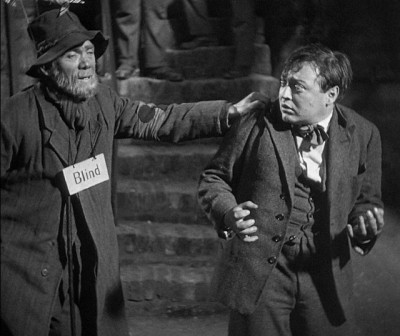
Yes, Fritz Lang’s first sound film, M (1931), has a few awkward moments in which Lang hasn’t quite mastered the new medium, but this old warhorse of art cinema works more than it doesn’t, and still registers as a compelling work by one of the undisputed masters of film. And calling it an old warhorse is no insult, since the reason things become warhorses is because they’re so good. As a story, it’s the perfect blend of Lang’s penchant for serial-like melodrama with something more on its mind — and in this regard, it’s probably only second to his next film, The Testament of Dr. Mabuse (1932), as a successful fusion of the two elements. It is probably not accidental that the two films are connected by the presence of Otto Wernicke as the same character, Inspector Lohmann, in each. On the one hand, M is a crime thriller with a twist. Not only do we have the police on the hunt for a serial child murderer, Hans Beckert (Peter Lorre), but the criminal underworld joins in the hunt. This is not from any altruistic motive, mind you. The underworld has grown tired of too much interference from the police thanks to their increased presence in the search for the murderer, so it follows that his capture is in their best interest. Lang is fascinated by the mechanics of both forces engaged in this manhunt, but he’s equally interested in the psychology of Beckert himself — a character who manages to generate a measure of sympathy because he can’t help himself. No film had previously dealt with the idea of a serial killer like this — and few films have ever topped it for psychological perception. It’s entertaining, exciting and distinctly disturbing.
Classic World Cinema by Courtyard Gallery will present M Friday, June 14, at 8 p.m. at Phil Mechanic Studios, 109 Roberts St., River Arts District (upstairs in the Railroad Library). Info: 273-3332, www.ashevillecourtyard.com.




Yes, Fritz Lang’s first sound film, M (1931), has a few awkward moments in which Lang hasn’t quite mastered the new medium,
I’d argue that some of the extended silent stretches lend an agreeably eerie chill to a couple of scenes, even if they play somewhat strangely and pull us out of the proceedings a bit.
I wasn’t so much thinking of those as I was the way some of the scenes cut together.
Ah. I’d give it another look, but I told myself I wasn’t allowed to sit down with M again until I’ve watched, or at least attempted to watch, The Gambler.
I’m presuming you mean the Dr. Mabuse films and not the Karel Reisz picture from the ’70s. It’s a long time since I’ve seen them, but I don’t recall them as hard to get through.
Well The Testament of Dr. Mabuse was a great watch. It’s the 4 hours or so I’m worried about with Dr. Mabuse: The Gambler. I understand it to be broken into two parts, but now it sounds as though you’re speaking of distinct movies collected under the single title?
The 1922 Dr. Mabuse: The Gambler is actually in two parts — The Great Gambler: An Image of the Age and Inferno: A Game for the People of Our Age — that were meant to be shown on two nights, not one sitting.
I should note that 1922 Lang film technique is a good bit less fluid and flashy than that of everything from Metropolis on.
Thank you for the clarification. Is there a “definitive” version you know of that I should be seeking out before I simply watch it on youtube?
I looked at the Youtube versions and they were pretty dire. My guess and from everything I’ve read, the Kino version seems to be the best one going.